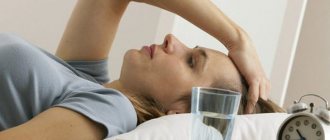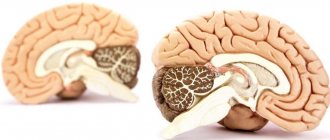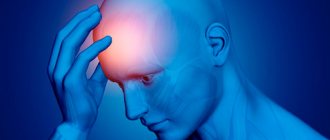Frequent headaches in women are not uncommon. It can manifest itself in different forms, have different intensity and character. However, in men it does not appear as often as in the weaker sex.
Frequent headaches in women may be accompanied by additional symptoms: tachycardia, nausea. Naturally, a woman needs to immediately consult a doctor.
Which specialist you need to consult depends on the general condition of the patient, his age, and medical history. Of course, the doctor must establish the reasons that triggered the headache.
Diseases that cause headaches
Diagnosing diseases based solely on the presence of headaches can be difficult: many disorders lead to pain in the head area. But it is still possible to identify a number of diagnostic guidelines. Severe headaches are caused by:
- eye diseases;
- diseases of the cervical spine;
- metabolic and endocrine disorders;
- pathologies of the vascular system;
- bacterial or viral intoxication;
- high or low blood pressure;
- traumatic brain injuries;
- injuries and ruptures of cerebral vessels;
- benign and malignant tumors in the brain.
As a result of chronic pathological processes, acute conditions can also develop, such as stroke, subarachnoid hemorrhage, tumor, meningitis (inflammation of the meninges). In such cases, only doctors can provide assistance!
In addition, a modern woman has to deal with a wide range of hybrid pains, when additional factors are superimposed on the disease, such as excessive coffee consumption, lack of rest or poor lifestyle. Here are the most common causes of pain in the head area.
Migraine
This type of headache is characterized by the fact that it can intensify from any irritant.
The pain is throbbing, has the character of attacks followed by short-term lulls, and can last from 2 to 72 hours. Localization is most often in one half of the head (not necessarily right or left, maybe the back or front). As a result, even with minimal physical activity or sudden movements, the pain intensifies. Patients experience photophobia, increased sensitivity to smells and sounds, nausea, vomiting, weakness, and malaise.
The attack may be preceded by an “aura” - a distortion of visual perception, sometimes it persists for a long time. An important point in stopping an attack is not only drug therapy, but also the creation of the most comfortable conditions for the patient:
- reduction of stress factors;
- good sleep;
- rest;
- proper nutrition;
- support with nutrients and vitamins.
If you have migraine, you should consult a neurologist, as it is a neurogenic pathology.
At the first stage, the specialist prescribes analgesics or non-steroidal anti-inflammatory drugs like ibuprofen. There are a variety of non-drug options for migraine symptom relief that can be very effective in prevention. For more severe forms of the disease, triptans, β-blockers, anti-depressants and serotonin antagonists are prescribed.
Cervical osteochondrosis
Osteochondrosis is characterized by degenerative changes in the bone and cartilage structure of the spine.
The upper cervical region suffers the most due to its anatomical structure. Due to improper functioning of the spine, nerve endings and important vessels that provide nutrition to the brain are pinched. Signs of cervical osteochondrosis:
- At the initial stage - constant, aching, nagging pain in the neck.
- At a later stage, they can be felt even during sleep and at rest.
- They are also felt in the back of the head, temples, and sometimes throughout the entire head.
- They can “give” to the neck, shoulder blades, and upper limbs.
- Causes impaired or decreased vision and hearing.
- Affect motor activity: turning the neck is difficult, the position of the head always seems “uncomfortable”. A person constantly tries to find a position in which pain will disappear.
- Causes weakness, dizziness, darkening of the eyes, fainting.
- Accompanied by numbness of the limbs.
- Cognitive impairments (memory, thinking and learning) are observed.
If a woman suspects cervical osteochondrosis, she should consult a therapist or neurologist. In the future, consultations with a vertebrologist, orthopedist, cardiologist, otolaryngologist and ophthalmologist may be necessary. In addition, an accurate diagnosis of the disease is necessary, since it can affect the entire body.
Hypertension
Some women do not feel high blood pressure at all, because they live with it constantly, in the background. The chronic form of the disease proceeds as follows: there is practically no pain, and a person is already accustomed to lethargy, drowsiness and heaviness in the head .
However, with “jumps” in blood pressure, unpleasant and painful sensations become more tangible, and then the person strives to quickly take some measures. With hypertension, the blood flow to the head is disrupted due to the fact that the vessels (arteries) are pinched, and the blood needs to “push” its way to the brain tissue.
The most common complaints with hypertension:
- localization is most often in the back of the head, but the pain can spread to the temples, forehead and neck;
- the pain is throbbing, aching, and can increase over time to an almost unbearable state;
- fatigue, tiredness immediately after waking up;
- dizziness and heaviness in the head;
- deterioration of memory and thought processes;
- depression, irritability;
- increased heart rate and sweating.
Treatment implies that it is necessary to reduce blood pressure to acceptable levels, and not just relieve the headache. That's why you need to consult a therapist and choose effective therapy .
Correction of eating behavior and lifestyle will not be superfluous, since hypertension is directly related to excess salt consumption, obesity, smoking, sedentary lifestyle (hypodynamia) and psycho-emotional stress.
Important to remember! Hypertension is deadly not so much in itself as because of its complications.
Glaucoma
Glaucoma is a group of eye diseases that are characterized by degenerative processes in the eyeball as a result of chronic or periodic increases in intraocular pressure.
This can lead to optic nerve atrophy, blurred vision, and even blindness. An acute attack of glaucoma is often accompanied by severe headache, which is initially difficult to diagnose. Sometimes it can be mistaken for manifestations of hypertension, meningitis, poisoning and other diseases.
It is important to know the characteristic symptoms of glaucoma:
- When palpated (to the touch), the eyeball becomes very hard!
- acute, sudden pain in the eye, which radiates to the corresponding part of the head, but can spread throughout the entire head;
- nausea and vomiting;
- general weakness and lethargy;
- the eye becomes red, the mucous membrane and eyelids become swollen;
- vision decreases.
The condition of acute glaucoma is extremely dangerous, as it is fraught with complete loss of vision; the patient requires hospitalization and urgent care from an ophthalmologist.
Cluster headache
Cluster (or beam) cephalalgia is pain that is concentrated in one strictly localized point of the head. It brings unbearable torment .
Difficult to diagnose as it is quite rare. This pain syndrome is provoked by primary diseases - migraine or neuralgia. It is called cluster because it haunts the patient with a series of peculiar painful outbreaks that begin and end suddenly. Cluster syndrome is characterized by:
- Sudden painful damage to the orbit and surrounding areas, most often affecting the same part of the head.
- The pain is burning, boring, it feels like “as if your head was pierced”, it is very difficult to endure.
- The pain increases over minutes, reaches a peak and recedes several times a day.
- The attack lasts from 10 minutes to 3-4 hours.
- An exacerbation of the disease can last for months, sometimes up to six months.
- The pain occurs at approximately the same time of day, is characterized by cyclicity, it can be tracked (it can wake you up even at night).
- The eyelid and mucous membrane of the eye swell, the white of the eye turns red, the pupil narrows greatly, and vision is difficult.
- Cardiopalmus.
- Alcoholic drinks often provoke attacks.
- Strong men are more often affected, but the disease also occurs in women.
Cluster pain is difficult to treat; doctors attribute its occurrence to disruptions in the parts of the brain that regulate circadian rhythms and metabolic processes. There is not enough research on this topic, treatment is experimental : medications, electrical stimulation of the vagus nerve, inhalation of pure oxygen, intense physical exercise.
Sinus headache
It is familiar to many people, since everyone has at least once suffered a bacterial or viral infection with severe sinusitis.
Sinusitis is an inflammation of the mucous membrane of the paranasal sinuses, accompanied by thick discharge, congestion and difficulty breathing. Main signs of sinusitis:
- high body temperature;
- a feeling of fullness and pressure in the forehead, eyebrows, cheeks, upper jaw;
- increased pain when tilting the head, sudden movements, or lying down;
- copious nasal discharge;
- lack of smell.
This disease is treated by otorhinolaryngologists (ENT doctors). Treatment involves suppressing a bacterial or viral infection and removing intoxication from the body.
Tension headache (TTH)
This type of pain is caused by stress factors, and each person may have their own. They arise against the background of chronic stress, depression and depression, “emotional burnout . Symptoms:
- Constant throbbing or pressing pain that can last from 2 to 24 hours.
- Feeling of fullness, pressure in the eye area.
- Tension (hypertonicity) of the muscles of the face and neck.
- Feeling of head stiffness.
The disease is accompanied by a decrease in performance and activity, and even a deterioration in the quality of life. However, the disease is benign and treatable. How is HDN treated :
- short-term drug therapy with a transition to non-drug methods;
- psychological and emotional support for the patient;
- normalization of wakefulness and sleep patterns;
- health-improving physical activity;
- regulation of eating behavior and drinking regime;
- compensation for deficiency conditions (vitamins, minerals);
- relaxation and stress relief skills;
- cognitive behavioral therapy;
- exclusion of provocateurs and triggers (trigger moments).
TTH does not seem that dangerous; it is not accompanied by symptoms such as vomiting or fainting , but it does a lot of harm to a woman’s body.
Worryingly, children and adolescents are also susceptible to TTH, which can lead to more severe problems with age.
To complete the picture, we will discuss another terrible disease.
Meningitis
Meningitis is characterized by severe headaches because the lining of the brain is involved in the process. The disease can be bacterial, viral or fungal in nature. Main symptoms:
- High temperature (38-39 degrees).
- Very severe headache that does not go away with medication.
- A red-purple rash reflecting blood poisoning.
- Limb spasms.
- There is stiffness and pain in the cervical spine.
- Nausea and/or vomiting.
- Problems with concentration, speech and movement.
- Lethargy, lethargy.
- Fear of light.
There is one characteristic symptom: when lying down, the patient bends his knees, pulling them towards his stomach, while bending his neck and head back strongly - this is one of the signs of meningitis.
Important! If these symptoms occur, seek immediate medical attention. The disease is deadly, develops rapidly, and can subsequently cause irreversible consequences (disability).
Diagnostics
In order for therapy to be as effective as possible in a particular case, diagnosis is an important process. In addition to collecting anamnesis, which will help in making a diagnosis, this process includes an examination by a doctor and the use of instrumental and laboratory tests. Among the most common:
- taking a general blood and urine test;
- blood pressure monitoring;
- electrocardiography;
- X-rays of the spine (its cervical spine), if cervical osteochondrosis is suspected;
- magnetic resonance imaging;
- CT scan;
- encephalography;
- ultrasound examination of the carotid arteries;
- measuring eye pressure;
- spinal puncture (performed if meningitis or hematoma of the subarachnoid space is suspected).
Provoking factors for headaches
In total, scientists identify about 200 types of headaches, and most of them are secondary, that is, caused by some underlying disease, the causes of which must be sought. But for each type it would be fair to indicate a number of provoking factors that can intensify the pain syndrome:
- Bad habits (smoking, alcoholism).
- Uncontrolled use of medications.
- Chronic stress, depression.
- Lack of vital vitamins and minerals.
- Inflammatory processes in the body (dental caries, gastrointestinal disorders, chronic infections).
- Errors in nutrition.
- Overweight.
- Low physical activity.
- Violation of sleep and rest patterns.
Elimination of these factors should be the basis of any method of treating headaches.
Meningitis
A severe, prolonged headache may indicate the onset of a more dangerous disease than all those mentioned above. Meningitis is an inflammation of the membranes of the brain, which is a consequence of another disease, or manifests itself regardless of other factors.
In the first case, the infection spreads to the brain, accompanying inflammatory processes such as:
- sinusitis;
- otitis;
- dental diseases.
In the second case, the infection enters the body through:
- bronchi;
- intestines;
- nasopharynx;
- open injuries of the skull or spinal column;
- during operations.
Inflammation occurs, manifesting itself in the following symptoms:
- severe pain in the frontal region, in which any sound becomes painful;
- stiffening of the neck muscles;
- increased heart rate;
- temperature rises to 40 degrees;
- rapid breathing;
- rash;
- vomiting, after which nausea does not go away, is caused even when changing position.
Meningitis is diagnosed only after taking cerebrospinal fluid, using a lumbar puncture and taking a glucose test; with purulent meningitis, glucose decreases to zero.
Treatment of meningitis involves the use of the following groups of drugs:
- antimicrobials;
- antibiotics;
- glucose;
- analgin;
- vitamins;
- methyluracil.
Hospitalization for meningitis is inevitable. If treatment was carried out in a timely manner, then headaches, after recovery, disappear after three months.
Otherwise, there is a risk of complications after meningitis, manifested in:
- decreased hearing;
- decreased vision;
- intracranial hypertension;
- epilepsy;
- persistence of headaches.
Persistent headaches
Pain relief is the elimination of pain using medications or therapeutic procedures. At this stage, doctors are able to successfully relieve headaches using analgesics or non-steroidal anti-inflammatory drugs, as well as physical therapy and psychotherapeutic methods. And yet there are categories of headaches that are difficult to treat. These are, for example, the cluster pain described above.
Neurogenic pathologies also cause a strong pain response to seemingly simple stimuli.
For example, a person perceives tactile or temperature stimuli as painful sensations, he develops an increased reaction to cold or heat, paresthesia (tingling, numbness, crawling) and allodynia occurs - pain in a separate area of the body from light touch, pressure or stroking.
Strange pains (like phantom ones) occur, which are localized throughout the body, including the head area. Unfortunately, they are difficult to treat.
Cervicocranialgia
Headaches that occur as a result of injuries to the cervical discs, muscles or nerves in the same area are called churchogenic. Churchocranialkia is also a chronic disease due to damaged nerve endings.
The cause of pain may be:
- incorrect position of the neck, due to cervical osteochondrosis;
- after suffering cervical injuries;
- due to a hernia.
The localization of pain covers the neck, but it can also occur in the shoulders and arm, while numbness is felt in the areas of radiating pain. The pain is concentrated at the base of the skull, affecting the eye area, frontal part, and crown. Patients describe the pain as throbbing or sharp, it can intensify by turning the head, and change with pressure at the base of the skull.
Cervicocranialgia is accompanied by the following symptoms:
- nausea;
- dizziness;
- swelling around the eyes;
- difficulty swallowing;
- loss of vision.
The pain may last for hours or weeks. Treatment involves eliminating the underlying causes (hernia, osteochondrosis), as well as reducing pain and other symptoms using medication, massage, and acupuncture.
Cases in which you should consult a doctor immediately
It is necessary to urgently seek medical help if the pain rapidly increases or does not go away for a long time.
There may also be additional symptoms:
- loss of consciousness;
- cramps and spasms;
- movement disorder;
- pain radiating to the neck, shoulders and arms;
- cognitive disorders (impaired speech, memory, thinking);
- nausea or vomiting;
- photophobia and blurred vision;
- pain in the eyes or "aura" - optical visual effects;
- sound phobia;
- throbbing pain in certain areas of the head.
Before the ambulance arrives, it is not recommended to take any medications, as sometimes they can distort the real picture of the disease.
In addition, the patient may mistakenly take a drug purchased under the influence of advertising and which is completely inappropriate and even harmful for this disorder. For example, taking Pentalgin for migraines can only worsen the clinical picture.
What can be done to alleviate the patient's condition.
Massage
For diseases such as cervical osteochondrosis or cervicocranialgia, physical therapy or massage is often prescribed. It is better to entrust therapeutic massage to a specialist, but simple acupressure can be done at home.
For example, light pressure on the muscles at the base of the skull will help reduce pain due to arthritis, if movement coordination is impaired, you can also stimulate a depression at the base of the skull.
Acupressure facial massage also helps, which involves pressing or circular massage of the following areas:
- points at the base of the eyebrows on both sides;
- points at the base of the eyes on both sides;
- behind the earlobe;
- in the temporal region;
- area above the eyebrows.
Combing your head with a wooden comb in different directions will improve blood circulation. For hypertension, massage using the Mashkov method will help. The essence of the massage is to rub areas of the head, moving to the neck, then to the shoulder girdle, then moving down to the ridge and shoulder blades. Force impacts should not touch the spinal column.
How to relieve pain?
You need to understand that taking pills “for the head” can only relieve the symptoms of the disease, and not get rid of its cause. Comprehensive treatment and compensation for the deficiency of important substances is necessary for headaches to truly go away. And yet it is possible and necessary to alleviate the patient’s condition.
Acupuncture is known to provide significant relief from migraines. And many patients, after a cosmetic procedure - ear cartilage piercing, experienced an unexpected improvement in their well-being. These methods may seem strange, but sometimes they are quite effective.
Massage
A head massage will help increase blood circulation, eliminate fluid stagnation in the lymphatic system and, at least partially, relieve pain.
Performed by a specialist . Head massage, like any other, has contraindications; it is prohibited in the following cases:
- Acute inflammatory and febrile conditions (high body temperature).
- Nausea and vomiting.
- The presence of tumors of different origins.
- Purulent processes.
- Severe vascular pathology.
- Tendency to bleeding and hemorrhage.
- Hypertensive or hypotensive crisis.
Treatment
The therapeutic process involves not only relieving unpleasant symptoms, but also eliminating the root cause. In this case, taking medications, massage, therapeutic exercises, and, as a last resort, if the cause of headaches in women is a tumor, surgical intervention will help solve the problem.
Helpful information
Depending on the diagnosis, the treatment process differs. The range of medications used to relieve symptoms is also different. Most often, these include painkillers, antihypertensives, to relieve tension, eliminate dizziness, and antiemetics.
High blood pressure is reduced with Epan N - this diuretic should be taken once a day, but your doctor will give you more detailed instructions. Migraine attacks are eliminated by Sumitran and Sumamigren. If we are talking about headaches due to prolonged tension, Panadol with Milistan, Eferalgan is prescribed. They can also prescribe Almiral with Diclofenac, Nimesil, Nimid with Nimesulide. Ketorolac with Ketorol is considered no less effective.
Dizziness is eliminated by taking Vestibo and Betaserc. Relief of nausea when using Domperidone.
The duration of administration and their quantity are regulated by the attending physician after a complete diagnosis.
Massage
If the cause of the headache is cervical osteochondrosis, the doctor may prescribe a therapeutic massage. It can also be prescribed in other cases, if we are talking about poor blood supply to the brain or low blood pressure.
Therapeutic massage is somewhat different from the usual one and involves performing it by a specialist. The massage therapist should not sharply turn the patient’s head, as this may cause complications.
In addition to therapeutic massage, self-massage is performed. It is effective in the early stages, when symptoms are not pronounced. This process involves performing simple actions that are aimed at reducing pain:
- Rubbing the earlobes and behind the ears.
- Massage the area above the bridge of the nose between the eyebrows.
- Press and massage the junction between the thumb and index finger.
To get the effect, you need to do this for several minutes.
Prevention
Seizures can be reduced to a minimum by simple preventive measures. First of all, prevention will concern prohibitions or restrictions on certain bad habits that provoke pain. What absolutely should not be done during an acute attack of headache:
- Drink alcohol . Drinking alcohol can temporarily relieve headaches by dilating blood vessels. This effect quickly passes, causing now a sharp narrowing of blood vessels and spasms. In addition, alcohol leads to a high degree of dehydration, the blood becomes thick, and red blood cells stick together. Drinking large amounts of water along with alcohol cannot completely eliminate the harm; dehydration cannot be stopped in this way.
- Uncontrolled use of medications . The reality is that people consider any medicine advertised to be harmless and exclusively beneficial. Side effects are not given any importance, dosage periods are not observed, and pills are “populated” haphazardly and for any reason. This can trigger major changes. The less drugs enter the body, the greater the benefits. Natural remedies are preferable to medications. I especially want to emphasize the harm of repeatedly taking a drug that did not work the first time. Increasing the dose in this case is not an option!
- Smoking . Smoking provokes vasospasm, which further worsens the patient’s condition. Reducing or eliminating smoking is a very effective step!
- Consume food industry products, fast food . At the chemical level, harm will be caused by everything that is highly processed: sausages and deli meats, store-bought baked goods and sweets, smoked and canned foods, foods with sweeteners, soda, low-calorie desserts, Asian dishes with MSG and spices. All these products contain chemically aggressive substances that can worsen the patient’s well-being.
Glaucoma
The headache that accompanies glaucoma is caused by increased blood pressure in the eye area. In addition to pain and pressure, the symptoms of the disease manifest themselves in a gradual decrease in vision, first peripheral, then the visible area narrows more and more.
The onset of glaucoma can be noticed when vision decreases at night, frequent blurred vision, or when rainbow circles appear when looking at a light bulb.
With glaucoma, due to the lack of release of eye fluid into the bloodstream, pressure increases, as a result of which the optic nerve is destroyed. If the disease is not treated, the patient risks going blind forever. People over 40 years of age, as well as those suffering from myopia, are at risk for glaucoma.
Women are most often susceptible to closed glaucoma, in which blindness occurs 3-5 years after the onset of the disease, slowly killing the optic nerve. In addition, closed glaucoma is characterized by an acute attack in which vision is lost suddenly.
Treatment for glaucoma involves reducing eye pressure with eye drops and improving blood circulation inside the eye. In advanced forms of the disease, surgery is indicated.
Drugs
Without a doctor's prescription, it is worth remembering that the simpler the drug, the safer it is. Simple analgesics will not relieve intense pain, but for moderate pain it will.
You can take medications such as:
- Analgin;
- Aspirin;
- Acetylsalicylic acid;
- Baralgin M;
- Paracetamol;
- Ibuprofen;
- Citramon.
However, if the patient is taking any other medications, then mixing one drug with another can cause the opposite effect and add unnecessary symptoms.
What is she talking about
According to many experts, a healthy person experiences pain up to 2 times a week .
If it appears more often, does not allow full activity, or other alarming symptoms are mixed in, you should consult a doctor.
Main symptoms:
- Appears on both sides.
- It lasts quite a long time, causing severe discomfort, but is not characterized by excessive intensity.
- The patient can work, even carry out sports activities. This does not change the nature of the pain.
- Not all patients classify unpleasant symptoms as headaches. They indicate a feeling of constriction and believe that they need rest.
- The symptoms are not accompanied by unpleasant sensations in the gastrointestinal tract, and patients practically do not react to irritants coming from the environment.
Migraine symptoms:
- Pulsating in nature, usually appears on one side only.
- Medium or high intensity, unpleasant sensations are expressed, affect work activity.
- Physical activity provokes a change in the nature of pain, usually leading to its intensification. Even unnecessary movements are dangerous.
- The attack lasts several hours and may last 2-3 days. One patient may experience both long-term and short-term attacks.
- Painkillers may work at the beginning of pain symptoms, but then they are useless.
Headache, why it appears, how to treat:
Do you know what the signs of the onset of menopause are? You can read it by following the link.
This publication will tell you how to make bookmarks for books with your own hands.
How to determine your facial skin type? Let's find out in our article.











